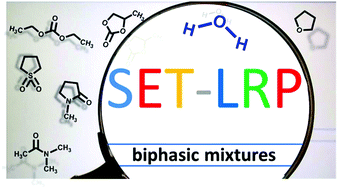Searching for efficient SET-LRP systems via biphasic mixtures of water with carbonates, ethers and dipolar aprotic solvents
Abstract
The recently developed “programmed” water/organic solvent biphasic reaction medium is the most efficient approach to expand the advantages of SET-LRP to next generation solvents and to enhance the performance of the current solvents employed in this polymerization methodology. This system has been successfully applied to families of solvents not accessible so far by SET-LRP such as polar and nonpolar non-disproportionation solvents. Here we report a series of screening experiments on biphasic mixtures of water with linear diethyl and dimethyl carbonates, cyclic propylene and ethylene carbonates, the cyclic ethers THF and dioxane, and with dipolar aprotic solvents. Two general methodologies were applied in the catalytic process: the accelerated “multicomponent” Cu(0) generated by the in situ reduction of Cu(II)Br2 with NaBH4 and the “single component” Cu(0) wire. All carbonates and ethers provide linear kinetic SET-LRP experiments when solvent/water = 8/2, v/v were used while under the same conditions dipolar aprotic solvents increased their apparent rate constant of polymerization up to about 3.5 times from the values obtained in the absence of water. These remarkable results demonstrate the power of the biphasic water/organic solvent mixture to the elaboration of new solvent systems for SET-LRP.



 Please wait while we load your content...
Please wait while we load your content...